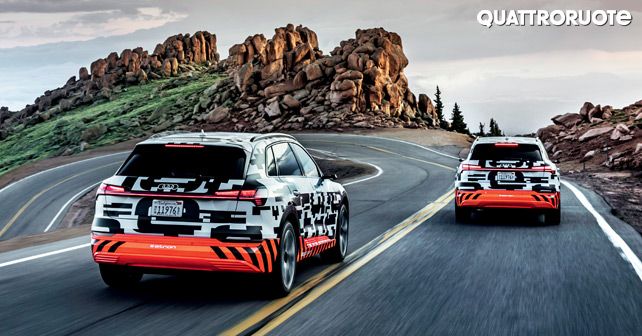
Audi's long-awaited e-tron SUV is finally here. But before it made its global debut our Italian colleagues took it for a spin up the famous Pikes Peak mountain in Colorado to experience what it actually feels like from behind the wheel.
The new Audi e-tron was launched in San Francisco, which essentially is Elon Musk’s home. I know what you’re thinking, but Ingolstadt claims that they simply chose California as the venue for the launch because it’s the right market for an electric SUV. While that may be true, a slightly ostentatious display of your new product in your enemy’s den doesn’t hurt, does it? Instead, in a sense, it actually helps – it demonstrates immense confidence in your product. Let’s just say that Audi is well aware of what it’s created – a model that, in terms of numbers, design and technology is a step ahead of the others. Equipped with advanced aerodynamics and superior performance, the e-tron takes a kind approach towards the environment, in terms of emissions as well as energy management.
In the build up to its launch, Audi showcased two concept cars. And during the 2018 Geneva Motor show, a fully camouflaged production version was unveiled. The response was overwhelming – some folks even wanted to purchase the car in its show-stand camo-avatar.
Now, given the levels of anticipations surrounding the e-tron, we were, naturally, curious to see how it would perform in the real world. And, as it happens, we got the opportunity to spend some time with the e-tron in Colorado – famous for the Pikes Peak hill climb. If you think about it, it’s the perfect place to test a particular aspect of an electric vehicle – the energy recovery system. Rolling down the hill for 30-kilometres requires you to constantly brake, and thereby test the efficiency of the car’s energy recovering system.
Between the Q5 & Q7
Before coming to its real-world performance, let’s take a look inside and underneath the e-tron –the first fully electric production car from Ingolstadt. With a length of 4,902mm and a wheelbase of 2,924mm, it slots in nicely between the Q5 and Q7 in terms of size – it will, however, cost more than the latter. It’s propelled by two three-phase asynchronous electric motors – the one at the front axle generates 168bhp and one at the rear develops 188bhp. Although it’s a little less than the Jaguar I-Pace, which has two motors of 198bhp each, it has something called ‘over-boost’ that works for eight seconds and gives the e-tron a peak power output of 402bhp and 664Nm, allowing it to accelerate to 100km/h in 5.5 seconds. The maximum speed is limited to 210km/h. Each engine has its power electronics and, of course, there’s no transmission. In the cabin, you do hear a hiss generated by the high frequencies of the inverters, which converts direct current into alternating current.
Regulating temperature
The optimal temperature of the battery pack is maintained through one of the four liquid-cooled circuits – the other three are for the powertrain, electronics and on-board charger. The circuits can be connected to each other since, in certain driving situations, the heat dispersed by a component can be useful for others. For instance, during winter, the excess heat of the inverter can be used to warm up the cold accumulator to make it more efficient during the first few minutes of a drive.
The 95 kWh battery pack of the e-tron can be charged from empty to 80% in just 30 minutes using a 150 kW fast charger. Of course, you can also use a standard domestic outlet (240V) as well, but this will take you about ten-and-a-half hours for a full charge. Based on the Worldwide harmonized Light vehicles Test Procedure (WLTP), Audi claims that the e-tron will have a range of over 400-kilometres. However, on a highway journey at higher speeds, the range drop by up to 30% – something that we’ve also observed in other electric vehicles like the Tesla Model S and X, Jaguar I-Pace and Hyundai Kona EV. But what happens when you’re driving up and down a twisty mountain road? Well, to test exactly that, we drove the e-tron down the tight hairpins of Pikes Peak.
Saving energy
Traditional electric cars store the kinetic energy generated during braking. However, the amount of energy stored varies according to the battery capacity of the vehicle. In the e-tron, Audi has significantly increased this ability to the extent that they claim that regenerative braking in the e-tron can regenerate up to 30% of the car’s range. This, of course, depends on the deceleration intensity. The more, and the harder, you brake, the more energy the car produces through regenerative braking. It’s a tall claim indeed, but, surprisingly, a true one – during our test drive, we experienced as much. We started at 4,300m above sea level, with 52kWh in the battery pack. After driving down for 30-kilometres and reaching 2,000m above sea level, we had gained 10.6kWh – almost 11% of its nominal capacity and over 40 kilometres of extra range. In short, this means that for each kilometre downhill, the car gained at least 1 kilometre in range.
Three way
The driver can select from three different modes – 0, 1 and 2 – to manage energy saving. Mode 0 allows the e-tron to coast without additional deceleration when you lift off the throttle. Moreover, the mechanical and aerodynamic resistance is minimal in this mode. This in part is achieved through its low drag coefficient of 0.28, thanks to a completely flat underbody and the external cameras, which replace the traditional rear-view mirrors. Mode 1 gives you an average deceleration of approximately 0.15m/s2 the moment you release the pedal. This level of deceleration makes the brakes virtually redundant. At low speeds, this is actually quite useful. Mode 2 allows for maximum recovery. The deceleration is adaptive, but not extremely pleasant at high speeds, since it forces you to constantly manage the pedal to keep a constant pace. On the highway, it’s better to put it in automatic.
Weighty affair
If not for its virtual rear-view mirrors and cameras, one might confuse the inside of the e-tron with that of an A6 or Q8. The interior layout is more or less the same. This means that the fit-and-finish is top notch, and there are two big touchscreens that dominatine the centre console, Audi’s Virtual Cockpit display and an enormous gear knob. There’s plenty of space inside the cabin for passengers – yes, even in the middle of the back row. The cabin is silent and the ride quality is plush. The ride in the e-tron is practically hiss-free, since there’s no engine noise. It features special Goodyear tyres with low rolling resistance.
With an enormous weight of around 2,500kgs, the body roll is evident in the corners, but it remains well balanced thanks to its low centre of gravity. The urgency with which it descended down during our test was really impressive. That said, the e-tron doesn’t feel as nimble or aggressive as the Jaguar I-Pace, which accelerates from 0 to 100 km/h in just 4.8 seconds. But, we’ll reserve our opinion on that front until we can pit the e-tron against the I-Pace.
The dashboard layout, with two touchscreens, is similar to that of the new A7 or Q8. The ‘gear’ lever, meanwhile, is absolutely enormous.
IT’S DIFFICULT TO BE SIMPLE
Like other electric vehicles, the e-tron too is simple in terms of its mechanics. However, Audi took a completely different approach than that of traditional electric cars to achieve this simplicity. Particularly difficult was the installation of the two motors, given the fact that they’re mounted on supporting frames anchored to the chassis and battery, forming a huge plateau between the two axles. The suspension setup includes a double wishbone axle at the front and a multilink setup at the rear, along with adaptive control and pneumatic springs. The e-tron is also capable of off-roading a fair bit.
So far, we’ve only seen rear-view cameras on concept cars, but now cameras have finally replaced rear-view mirrors on board of a standard model.
DIGITAL BRAKING
The brakes of the e-tron are only activated when the driver decelerates by more than 0.3g using the brake pedal – typically in the event of an emergency situation or during performance driving. In such cases, the brakes respond extremely quickly, due to a new electrohydraulic actuation concept – something that Audi is claiming to be the first of its kind in a series production electric vehicle. How it works is quite complicated – it uses a hydraulic piston in a compact brake module, which exerts additional brake force for the recuperation of torque. When emergency braking is activated, it only takes 150 milliseconds to initiate deceleration and apply maximum brake pressure. According to Audi, this setup reduces braking distances by up to 20% compared to a conventional braking system. The interesting thing is that, depending on the road conditions, the system decides – electrically on each axle – whether the vehicle should use the electric motors to slow down or the brakes, or a combination of the two.
© Riproduzione riservata






























Write your Comment